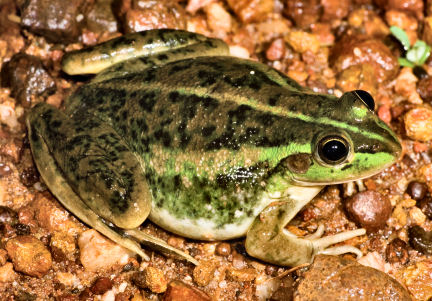An Australian snake feeds on dangerous frogs by striking them with venom and then backing off long enough for the frogs’ defense chemicals to degrade, say researchers.

The floodplain death adder (Acanthophis praelongus) even has different waiting times for each of two frog species, report Ben Phillips and Richard Shine of the University of Sydney. For the less dangerous frog, which exudes a nontoxic but entrapping goo, the snake waits about 10 minutes. For the frog carrying a lethal dose of toxin, the snake waits 42 minutes as the toxin loses its power.
“Snakes, despite the fact that they’ve got this tiny little pea-size brain, are clearly capable of recognizing what kind of frog they’ve bitten,” says Shine.
He and Phillips first saw the snake behavior during a recent project in Australia’s northern floodplains when they fed captured adders their usual diet of local frogs.
Testing an example of an easily edible species, the researchers offered adders rocket frogs (Litoria nasuta). An adder that strikes one of these frogs swallows it immediately, say the researchers.
Adders struck at marbled frogs (Limnodynastes convexiusculus) but, about a third of the time, released them immediately. As their defense mechanism, marbled frogs secrete mucus that binds leaves and twigs into a big clot on an attacker. Shine, who’s had his fingers glued together when trying to measure marbled frogs, says “it’s ridiculously difficult to wash off.”
In tests, Phillips and Shine found that the stickiness of the mucus declined by two-thirds if they let it sit 10 minutes—the typical time that adders wait before eating a marbled frog.
Studies a decade ago established that Dahl’s frogs (Litoria dahlii) carry a lethal toxin when first killed. In Phillips and Shine’s experiments, an adder would sometimes strike at a Dahl’s frog but would then release it immediately. As the frog died, the snake thrashed around too, sometimes lying on its back with its mouth open. “It’s like the snake has just had a mouthful of chili pepper,” says Shine. After recovering, the snake eventually would eat the frog, he and Phillips report in a paper scheduled for the December American Naturalist.
“People think frogs are nice little harmless things and snakes are big dangerous things,” says Shine. “In fact, the frogs have evolved interesting and quite different strategies that are very effective against most of the snakes that are their enemies. There is this whole arms race that is going on in these tropical floodplains.”
The adder’s delaying tactic should be “much easier to evolve than physiological resistance to the effects of the toxins” that some other snakes have, says Deborah Hutchinson of Old Dominion University in Norfolk, Va.
“It would be fascinating to know whether adders learn this behavior or have evolved genetic predispositions toward it,” says Edmund D. Brodie III of the University of Virginia in Charlottesville.
Shine says that he’s leaning toward the response being genetic because work he’s doing on the way in which adders cope with other toxic prey is “frankly not impressing us with the learning ability of the snakes.”
Shine is finding that the snakes try to eat invasive, toxic cane toads as if they were Dahl’s frogs. “The death adder gets caught in an evolutionary trap because the cane toad toxin remains toxic for many, many hours,” he says.





